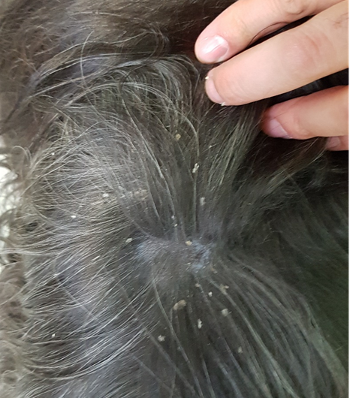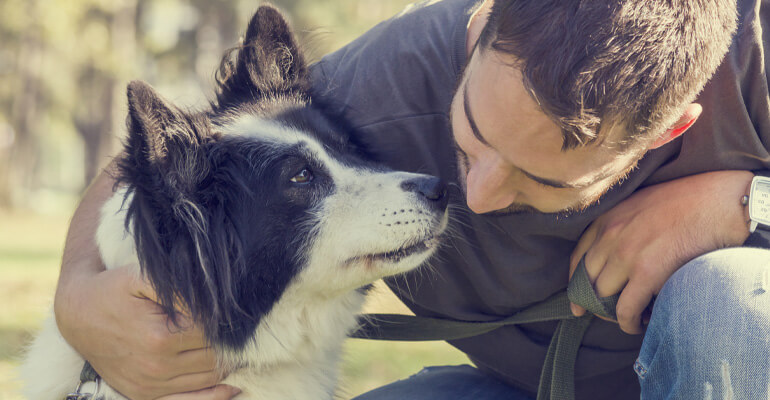Human dandruff is a well-known phenomenon, but did you know dogs can get dandruff, too? Maybe you’ve noticed that your dog leaves little white flakes behind on the furniture, or that they may be scratching more than usual.
Just like us, our canine friends can get a little flaky, which may cause itchiness and skin irritation. Some dogs with dandruff can also have a greasy coat due to excessive oils (sebum) being secreted by the skin. Having dandruff is no fun for us, so just imagine what it must be like for them!
Let’s explore the potential causes of this condition and how to treat dog dandruff.
What is dandruff in dogs?
As in humans, canine dandruff is caused by too many flakes of dead skin coming off, which then get stuck in the dog’s fur. Some more severe cases can even make it look like your dog just walked outside in a snowstorm!
In some dogs, the skin cell turnover can be too fast leading to cells being shed too quickly - seen as dandruff - and there can be a higher number and activity of the oil producing glands in the skin, called sebaceous glands. This leads to excessive oils (sebum) being released making the skin and fur feel greasy.
When should I see my vet about my dog’s dandruff?
The most common symptom is areas of the skin that are dry and flaky (picture 1), but your dog might also have redness, scaling, greasy spots, scabs, and thickened skin. If this is the case, you should err on the side of caution and see your vet.

Credit: Dr Chiara Noli
Picture 1: Large scales on the dorsum of a dog

Credit: Dr Mathieu Demoury
Picture 2: large scales on a dog presenting with greasy seborrhea. Hair loss, darkening of the skin and redness are visible
Dandruff can be an inherited (primary) problem or caused by an underlying disease (secondary). Inherited disease, such as primary seborrhoea, is not very common but can be seen in certain breeds such as Golden Retrievers. Dandruff caused by an underlying condition such as; environmental or food allergies, poor diet, bacterial or fungal infections, ectoparasites (fleas and mites), and metabolic disorders such as hypothyroidism are far more common.
If left untreated, some of these can lead to more serious problems, so it’s important to identify the culprit. While diagnosing the dandruff itself is quite straightforward, determining the cause can be trickier, and this is best left in the hands of your vet.
General dog dandruff treatment regime
Many dogs with dandruff respond extremely well to a multi-modal treatment approach that includes the following:
Topical products
Topical products can help rebalance the shedding process and support the skin barrier, reducing the flaking and greasy feel to the skin. In some cases topical support is sufficient, but others require further treatment depending on what the underlying cause is.
Seboregulating ingredients, which balance the skin’s sebum production, help to remove dandruff and regulate oil production so that your dog’s coat is flake free and no longer feels greasy. Some products can be harsh and drying, excessively removing grease that can damage the skin barrier and alter skin hydration; so it is important to use a product that is well tolerated by your pet.
Dietary supplements
Omega-3 fatty acids and vitamin E supplements are cheap and easy to administer and help to improve the quality of the fur. Often it is best to consult your vet on the best supplement to use in your dogs before purchasing.
Grooming
Keep your pet free of matts with regular brushing; for non-shedding breeds, make sure they are regularly seen by a groomer. Matts can predispose dogs to bacterial and yeast overgrowths on their skin and can also provide a fertile breeding ground for parasites leading to dandruff. Brushing can also help distribute your dog’s natural oils across their skin, helping to keep it supple and nourished.
Dog dandruff: Identifying the cause to find the appropriate treatment and home remedies
If you are concerned about your dog's dandruff you should visit your vet as there may be an underlying cause such as:
- Excessive bathing with an inappropriate shampoo
- Dry air
- Food allergies and environmental allergies
- Poor diet
- Bacterial/fungal infections and parasites
- Health conditions
- Primary seborrhoea
- Walking dandruff (mite)
Your vet may also recommend a sham
poo or mousse to help manage the dandruff while they get to the bottom of things.
Home remedies for dog dandruff
Home remedies are based on anecdotal evidence and advice and we would recommend you check with your vet before using. It is better to use a clinically proven shampoo or mousse to tackle this problem.. Talk to your vet about whether these are appropriate for your dog and how to use them.
Get rid of dog dandruff for good!
The good news is that canine dandruff is relatively easy to treat. The main challenge is to find the underlying cause. Once that has been identified and treated, managing dandruff should be much easier. In animals for whom a cause couldn’t be determined, or one that is difficult to control, there are excellent products on the market to help get rid of flakes. With the right treatment plan, your pooch is sure to be feeling better in no time!
DOUXO® S3 SEB- anti dandruff formulation with skin barrier support
DOUXO® S3 Seb is a unique combination of natural ingredients that supports normal production of skin cells and it has soothing and moisturizing properties. Because of its unique formula, DOUXO® S3 Seb products can help manage all types of greasy or flaky skin.
- Douxo® S3 has proven performance on all 3 skin barriers (mechanical, immune system and microbiological - bacteria on the skin). It also has been shown to be well tolerated on both normal and irritated skin.
- Soap, sulphate, paraben, colourant, phthalates and nanoparticle FREE
- An adjusted pH to promote a rich and diverse microbiome (bacteria, fungi and other microbes that live on the skin)
- Hypoallergenic fragrance selected by pet owners: Coco+Vanilla - fragrance of summer - 97% of owners love the texture and smell!
- Thanks also to the close collaboration with pet owners during the process to select the fragrance and ergonomics of the packaging, DouxoⓇS3 is designed for maximum customer satisfaction


